While Svalbard is a beautiful place to visit, it’s also an extremely expensive one… which means it becomes even more imperative to pick the right time to visit Svalbard for the experiences you’re hoping for.
Here’s the rub: for many, Svalbard is a “once-in-a-lifetime” type of place. Between expensive flights and the necessity of taking a lot of tours because independent travel is all but impossible to non-locals, you can expect to spend a pretty penny in Svalbard.
But here’s the other thing: there’s no way you can ever do all the activities that make Svalbard so special in one single trip, simply because this place is so seasonal and conditional upon the weather.
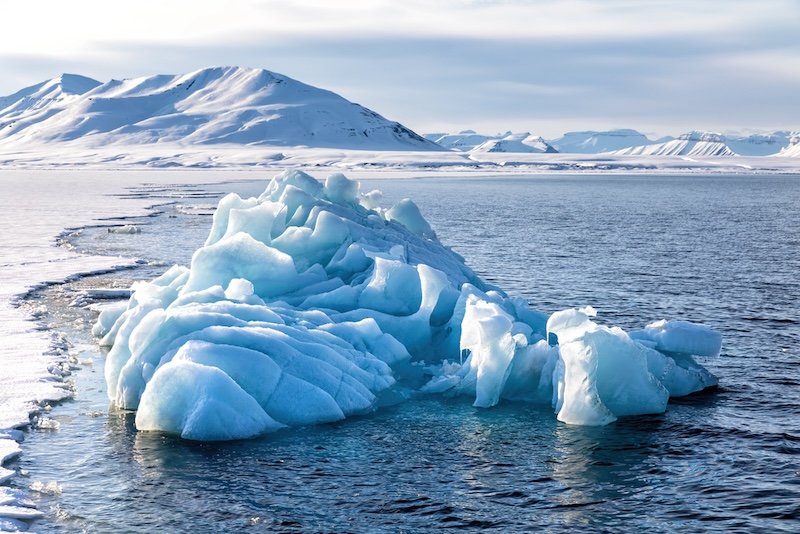
Planning your Svalbard itinerary means making some hard choices. Unless some very specific conditions align, you won’t be able to dog sled across the frozen tundra and go kayaking among glaciers in the same visit.
If you’re not bound to a specific vacation schedule and have the luxury of choosing when to visit Svalbard, I advise you think about what activities you want to do first, and then from there, pick the right month within that time period.
Table of Contents
The Three Seasons of Svalbard
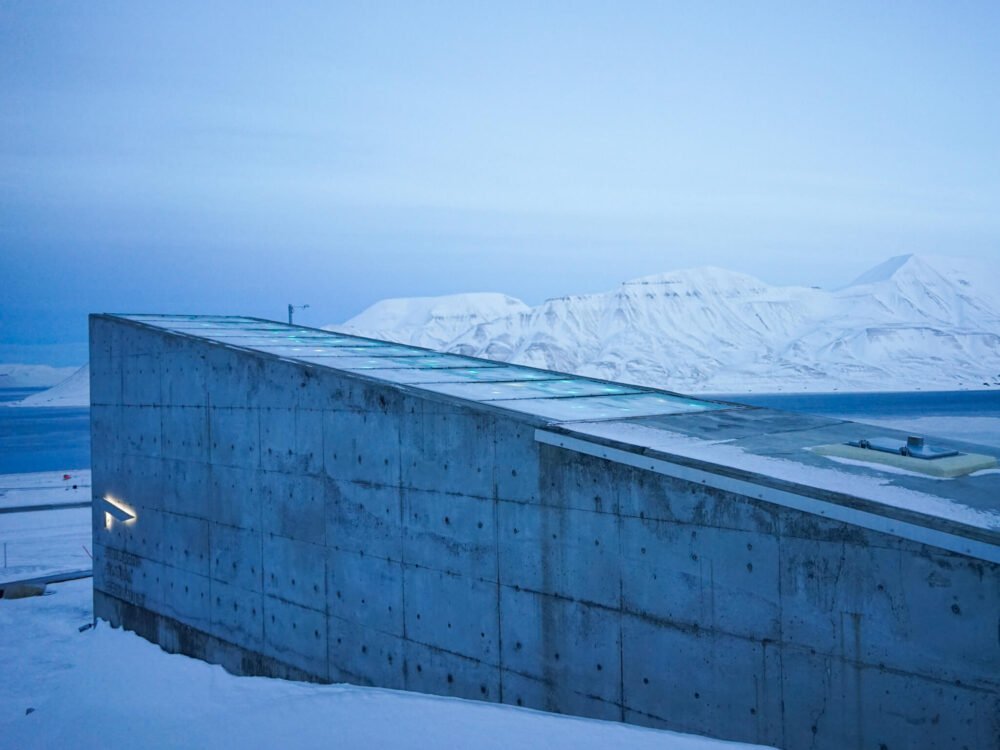
Forget what you knew about the four seasons in temperate climates or the two seasons in tropical climates. Being so close to the North Pole, Svalbard really has three seasons — and two are just different flavors of winter.
As agreed upon by Svalbard residents, the three proper seasons in Svalbard are:
- Sunny Winter (March through Mid-May)
- Polar Summer (Mid-May through September)
- and Northern Lights Winter (October through February)
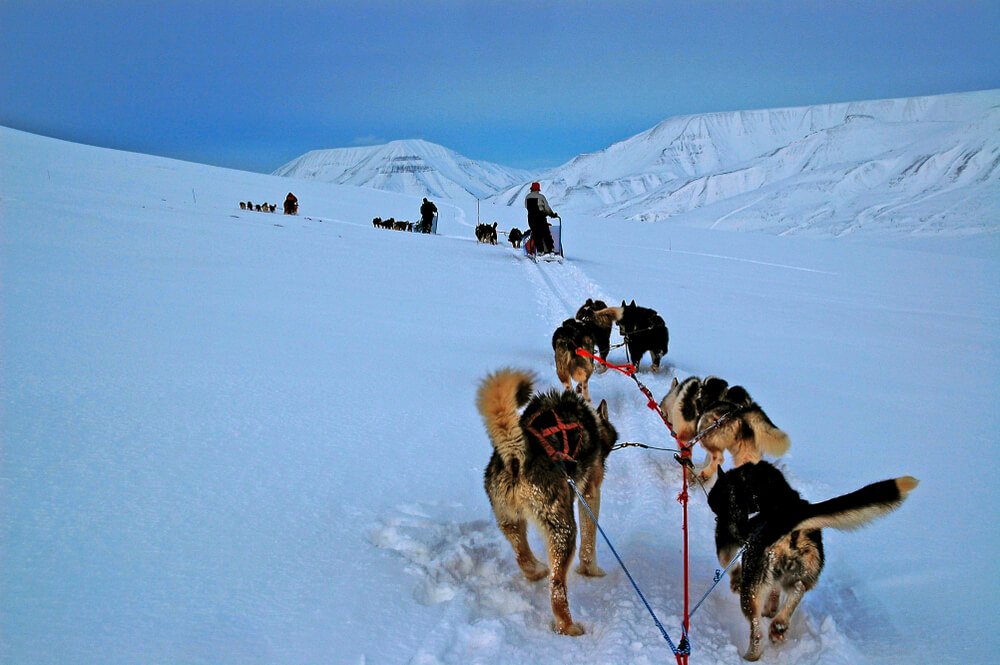
This post will start with sunny winter as that’s really when the tourism season starts in Svalbard, although some snow activities like visiting the ice caves do begin a little earlier in February.
February was when my visit was, so I have the most personal tips and advice from that period, and I’ll be writing a dedicated post about visiting Svalbard in February soon.
Sunny Winter (March to Mid-May)
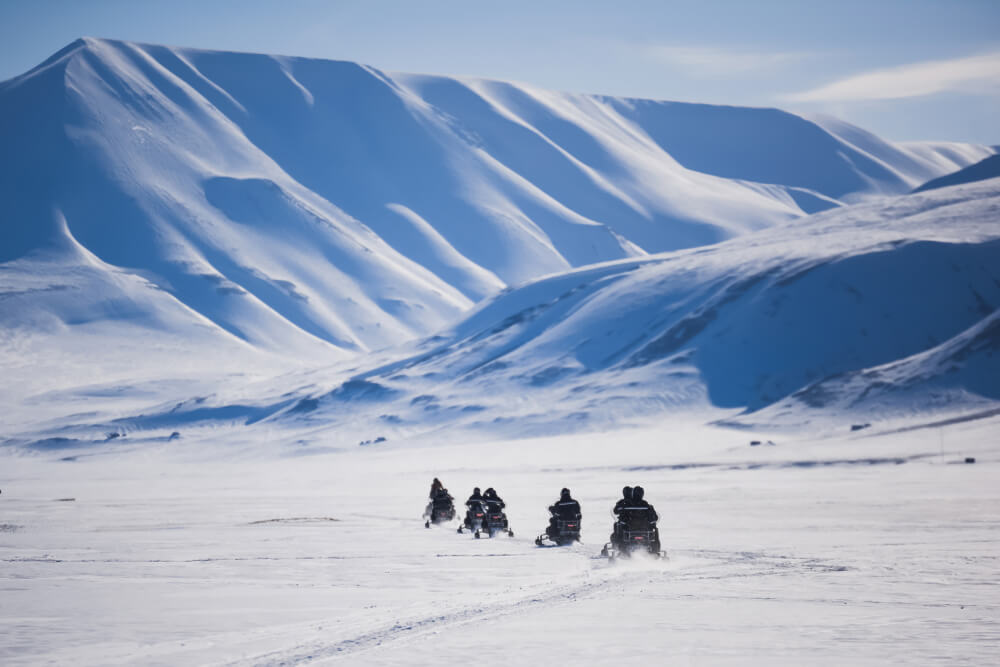
Pick sunny winter if…
✔️ You want to go snowmobiling and dog sledding
✔️ You want to enjoy Svalbard before cruise ships start docking
✔️ You want to enjoy the cold of winter with the benefit of long sunny days
Skip sunny winter if…
❌ You want to see the aurora borealis
❌ You really can’t handle the cold
❌ You want to see lots of wildlife
March in Svalbard
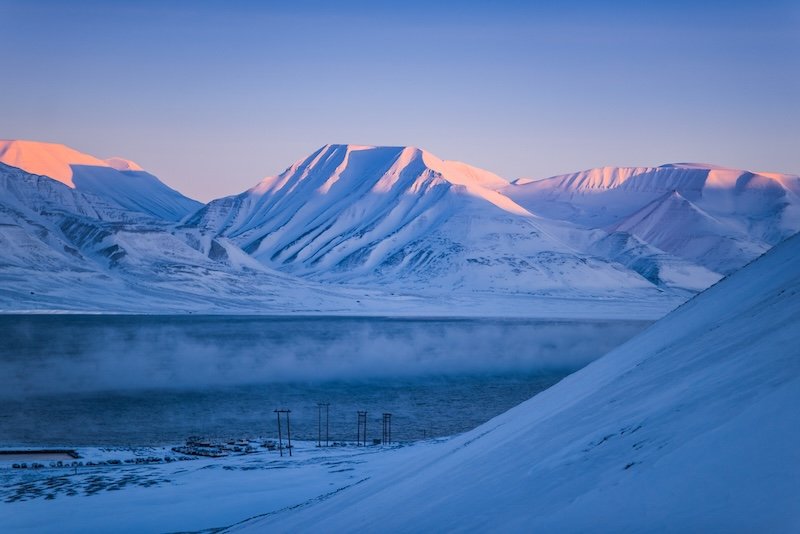
At a Glance:
- Temperatures: Average highs of -8°C (18°F), average lows of -14°C (7°F), with much lower days possible.
- Sunlight: The sun returns on Longyearbyen at the beginning of the month and days are bright, almost endless by the end of the month.
- Activities: Snowmobile safaris, visiting ice caves, dog sledding, aurora tours possible at the beginning of the month
March may be the most rapidly changing month in all of Svalbard’s winter season!
The beginning of the month has days that are about 7.5 hours long, with sunrise around 8:30 AM and sunset around 4 PM. But by March 15, sunrise is already at 6:30 AM (a full two hours earlier in just two weeks) and sunset is around 5:45 PM (nearly two hours later), giving you 11 hours of daylight.
By March 30th, days stretch as long as the longest summer days in lower latitudes. By now, the sunrise is around 5:20 AM and sunset isn’t until 8:45 PM — plenty of time to explore and enjoy!
As usual, you can expect twilight hours to stretch about two hours before and two hours after sunset, giving you even more light… and thus ending the aurora season in Svalbard rather abruptly.
With so much sunlight and also so much snow, this is the best season for all the snow sports!
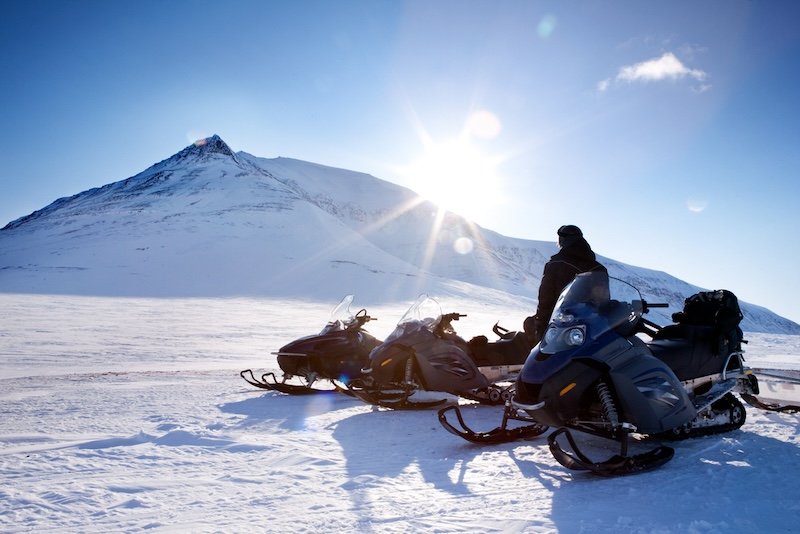
Snowmobiling trips like this one to East Spitsbergen or this one to the ice caves are a great way to enjoy the sunny winter months. It’s the only way to see certain parts of Spitsbergen that are generally inaccessible at other parts of the year.
A particularly unique snowmobile excursion only available in March and parts of April is this blue light snowmobile safari, where you get to see Svalbard in its most beautiful colors, not quite day and not quite night!
March is also a very festive feeling month in Svalbard because this is when the town of Longyearbyen celebrates Sun Festival Week, the week leading up to March 8, full of concerts and fun cultural activities.
While the first sunrise for the year will have been in mid-February, it takes about 3 weeks for the sun to rise high enough above the horizon to peek above the tall mountains that block light from the east from falling on Longyearbyen.
| Overall Rating for Visiting: ⭐⭐⭐⭐ (4/5): The sunlight is beautiful and snow is plentiful for snowmobiling and winter sports, but this is often the coldest month of the year, so bundle up and pack wisely. Coming during Sun Festival Week can be a ton of fun to celebrate the unique return of the sun to this high Arctic town! |
April in Svalbard
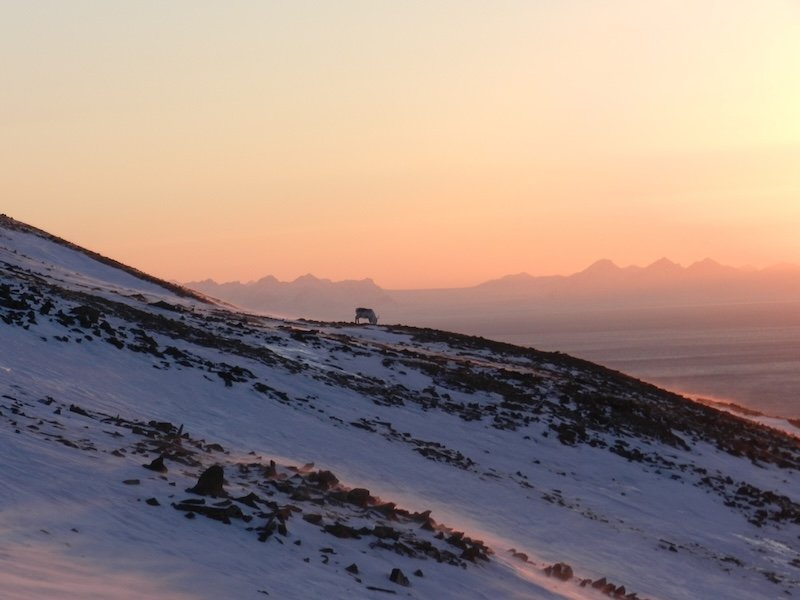
At a Glance:
- Temperatures: Average highs of -5°C (23°F), average lows of -10°C (14°F).
- Sunlight: The month begins very bright and ends in midnight sun, starting on the 18th.
- Activities: Snowmobiling, ice caves, dog sledding,
It may be hard to believe that a month where the Midnight Sun begins can be considered winter, but Svalbard is an unusual place!
On April 1, sunrise is around 5:15 AM and sunset is at nearly 9 PM… already almost 18 hours of daylight! By April 18, though, you’ll see the last sunset for several months, when the sun sets for the final time for several months, translating to 24/7 sunshine at the end of April.
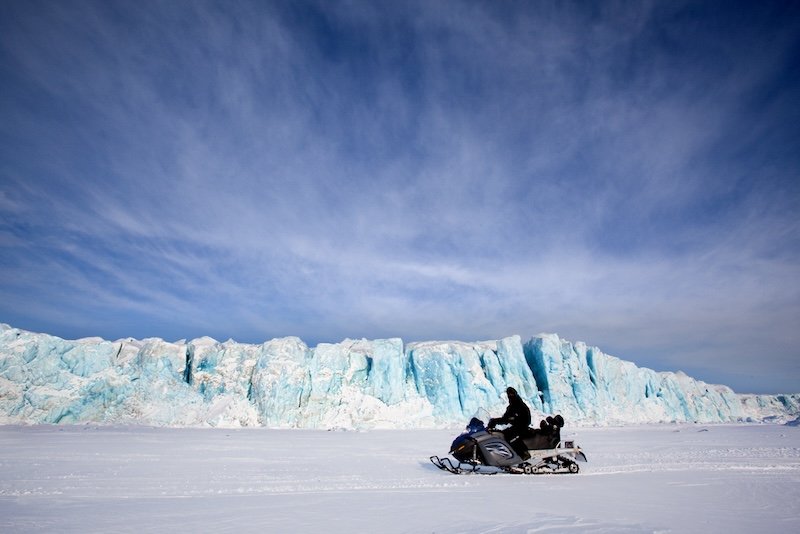
This is another great month for snow sports before the warmer months settle in and end snowmobile season. Snowmobile trips are a major draw at this time of year — I recommend the snowmobile tour to Eastern Spitsbergen and the snowmobile safari to glacier ice caves.
This is also still prime dog sledding season, and you can join tours to the ice caves or around Adventdalen or Bolterdalen if you want a less strenuous, more relaxing dog sled experience.
| Overall Rating for Visiting: ⭐⭐⭐⭐ (4/5): The combination of midnight sun and all the snow sports you can dream of is a perfect combination. However, most boat tours haven’t yet started, and the migratory birds and other wildlife generally haven’t returned yet. |
May in Svalbard*
May in Svalbard*
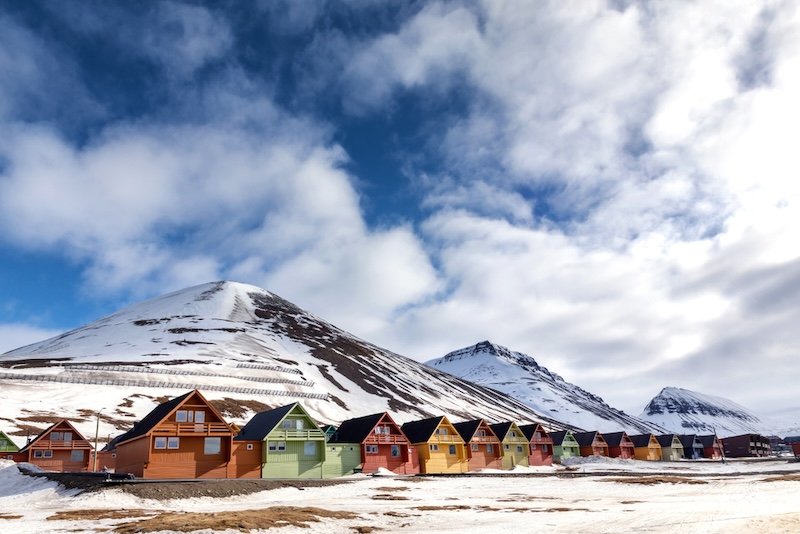
* Technically, the first half of May falls under “sunny winter” and the second half falls under “polar summer”. But since you can still often do many snow activities at the beginning of the month, I’ll put it in the winter section.
At a Glance:
- Temperatures: Average highs of 1°C (34°F), average lows of -3°C (27°F)
- Sunlight: Full sunlight all month long
- Activities: Snow sports like snowmobiling at the beginning of the month, changing to boat tours and hiking-based activities by end of the month.
Welcome to the full-on midnight sun season: there are no sunrises or sunsets all month! May is the transitional month between Svalbard’s sunny winter and polar summer seasons, but it feels very summery with never-ending days. Plus, average temperatures finally climb above freezing: what passes for balmy in this part of the Arctic Circle.
This isn’t quite a shoulder season month, because it’s very much high season in Svalbard. However, the unique opportunity to enjoy both snow and boat activities is only possible at this time of year. However, the timing is hard to get exactly right, so it should be thought of as a bonus if everything aligns.
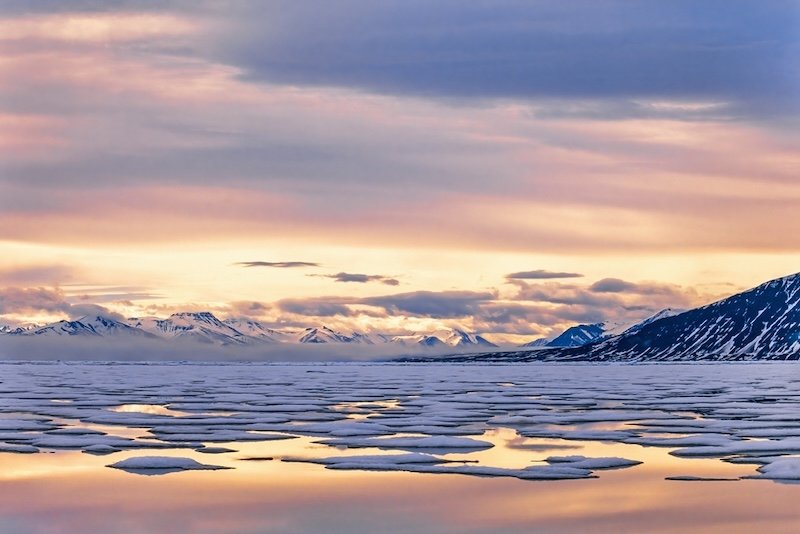
It depends on the temperatures this time of year, but usually around halfway through the month, snow sports like snowmobile safaris and dog-sledding on the snow come to an end. Until then, though, you can enjoy activities like midnight sun snowmobiling and even snowmobiling all the way to Eastern Spitsbergen in hopes of spotting polar bears where they’re most likely to be.
Once there’s not enough snow for snow sports, activities shift more towards boat trips (such as ones to walrus colonies as well as RIB safaris to glaciers), hiking tours, and dog-sledding on dry ground using a cart with wheels rather than a dog sledge.
| Overall Rating for Visiting: ⭐⭐⭐⭐⭐ (5/5): Midnight sun, boat season starts, and if you’re lucky you may still have enough snow for some snowmobile trips! This is the best of all worlds for Svalbard… and it’s before cruise season starts. |
Polar Summer (June to September)
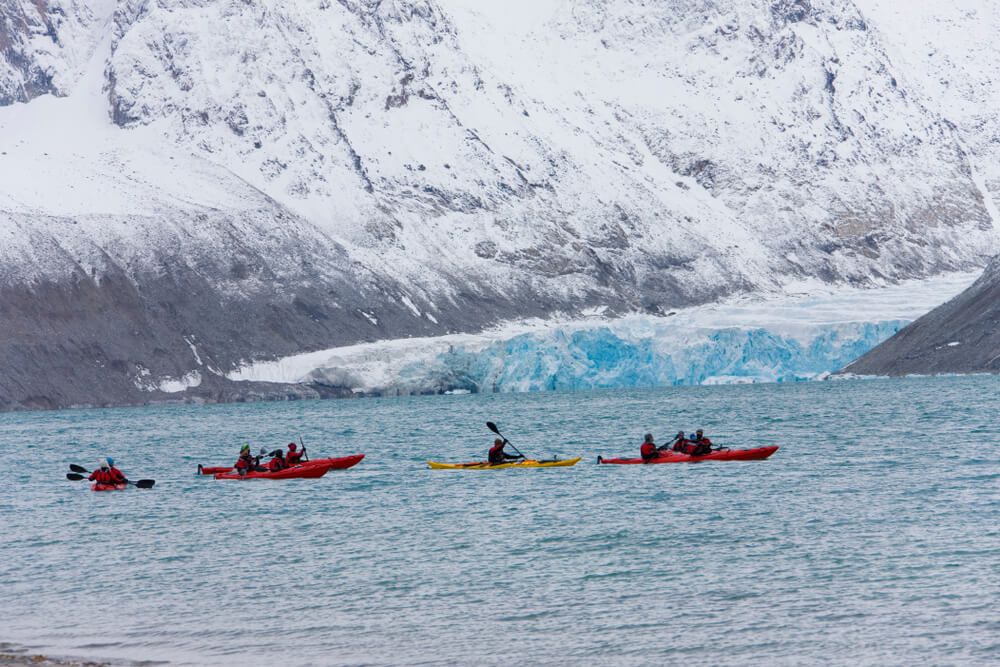
Pick polar summer if…
✔️ You want to go on boat trips and visit other parts of Svalbard
✔️ You want to see wildlife, including possible polar bears
✔️ You want to experience the sun never setting!
Skip polar summer if…
❌ You’re bothered by cruise ship crowds
❌ You’re traveling on a tight budget
❌ You want snow and Northern lights
June in Svalbard
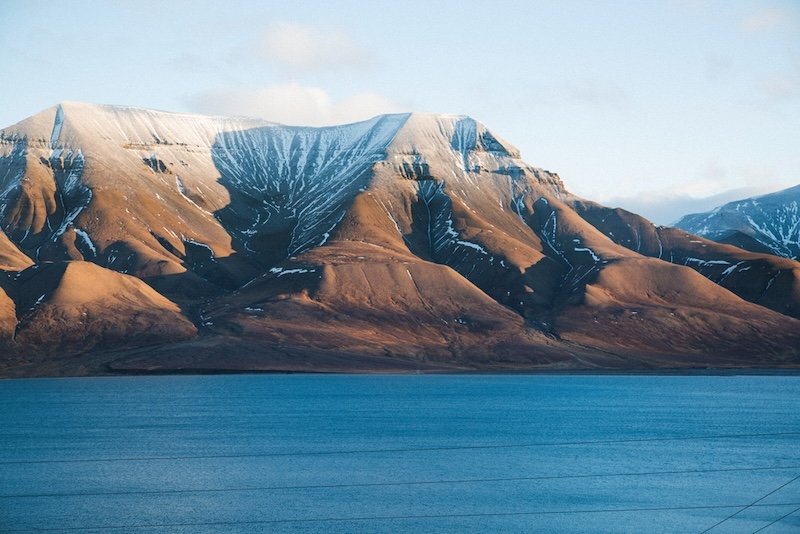
At a Glance:
- Temperatures: Average highs of 6°C (43°F), average lows of 3°C (38°F)
- Sunlight: Full sunlight all month long
- Activities: Boat tours, sea kayaking, wildlife excursions, hiking
June is full polar summer at its best — all the outdoor activities around this time of year focus on boat trips out on the Arctic Ocean!
Now that it’s finally calm enough and sea ice has subsided some, it’s possible to visit some of the more remote places like Ny-Ålesund, the research town that’s the northernmost permanent settlement in the world, and Pyramiden, an abandoned Soviet-era mining town.
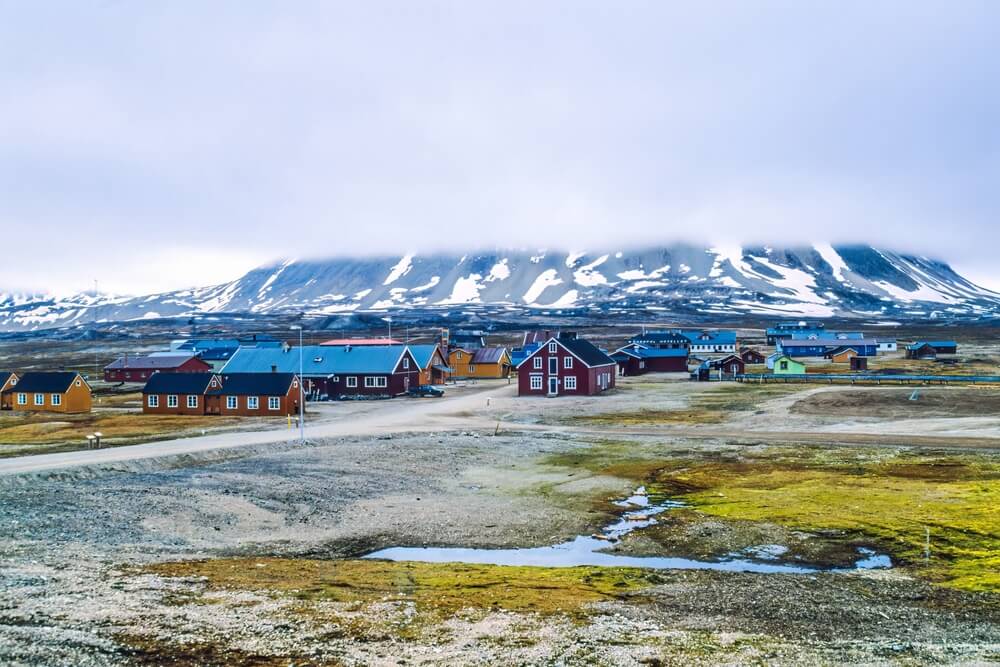
Also, sea kayaking season begins again! This is one of the most unique things you can do in Svalbard but you can only do it for a short window of perfect conditions during the summer months, from June through August.
This is the first month that the migratory birds begin to return to Svalbard, meaning you can do fjord safaris to bird cliffs and also do land-based photo safaris. This is also when you have the best chance to see polar bears on a boat tour, especially if you’re going further afield.
Wildlife lovers will also love the chance to go on a walrus safari to Borebukta, a walrus colony where you’re basically guaranteed to see these enormous sea clowns.
| Overall Rating for Visiting: ⭐⭐⭐⭐ (4/5) Relatively warm temperatures, all the boat activities you can dream of, and endless summer days! The downsides are that all the snow sports have ended and cruise ship season has begun. |
July in Svalbard
At a Glance:
- Temperatures: Average highs of 10°C (50°F), average lows of 6°C (43°F)
- Sunlight: Full sunlight all month long
- Activities: Boat tours, sea kayaking, wildlife safaris on land and sea, guided hikes, enjoying the midnight sun
Boat season continues under the midnight sun all July, which also happens to be the warmest month in Svalbard… though that’s not necessarily saying much in the polar regions.
You can take a boat tour to Ny-Ålesund, go kayaking among glaciers, visit walrus colonies by RIB boat, etc. Virtually all boat tours operate during this month giving you tons of choices.
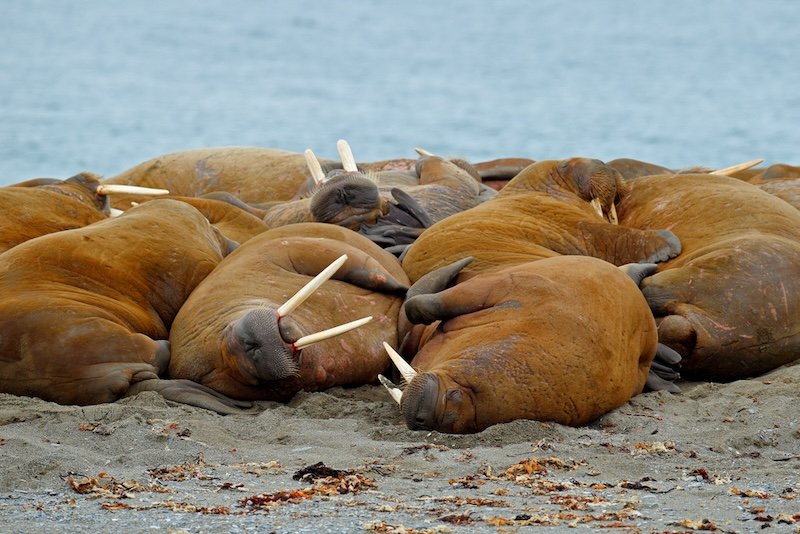
If you’re looking for some stuff to do on land, you can take a wildlife photo tour from Longyearbyen, where you’ll travel by car around the wilderness parts of town and see what you can spot, including Arctic foxes and birds.
You can also go on a variety of hiking tours in the mountains around Longyearbyen, but note that you must always hike with a guide due to polar bear safety measures.
| Overall Rating for Visiting: ⭐⭐⭐⭐ (4/5) The warmest month in Svalbard! This is a full month under the midnight sun, lots of different boat tours you can choose from, but this is another peak season month with lots of cruise ships arriving and making Longyearbyen extremely busy. Also quite pricy. |
August in Svalbard
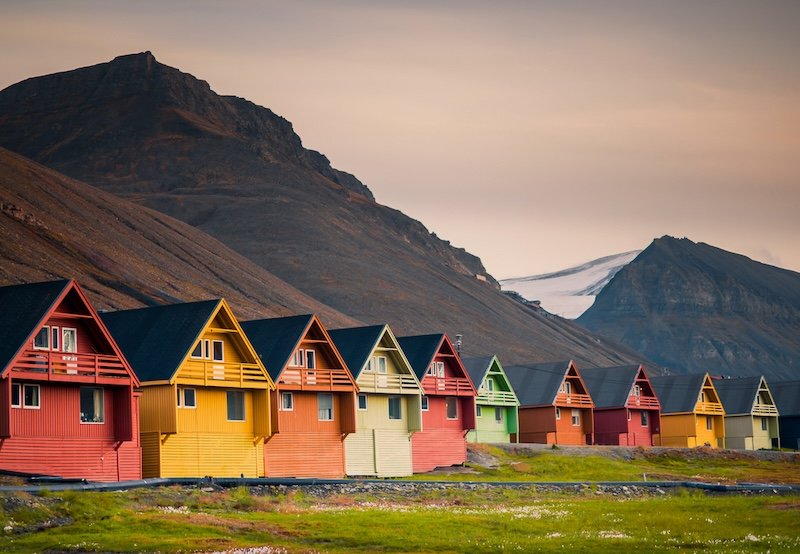
At a Glance:
- Temperatures: Average highs of 9°C (49°F), average lows of 5°C (41°F)
- Sunlight: Full sun for most of the month, with midnight sun coming to an end around the 25th.
- Activities: Boat tours and excursions, kayaking, hiking tours, birdwatching and wildlife excursions
August in Svalbard is all about exploring Spitsbergen by boat and on foot! This is the last month you can enjoy some activities that require calmer seas, like sea kayaking among glaciers, and the RIB boat tour to the walrus colony in Borebukta.
If you’re looking for something land-based to mix it up, consider this wildlife photography safari, which departs by car from Longyearbyen and brings you on guided hikes to areas where some of the archipelago’s most iconic land-based wildlife, such as Svalbard reindeer and Arctic foxes, like to hang out.
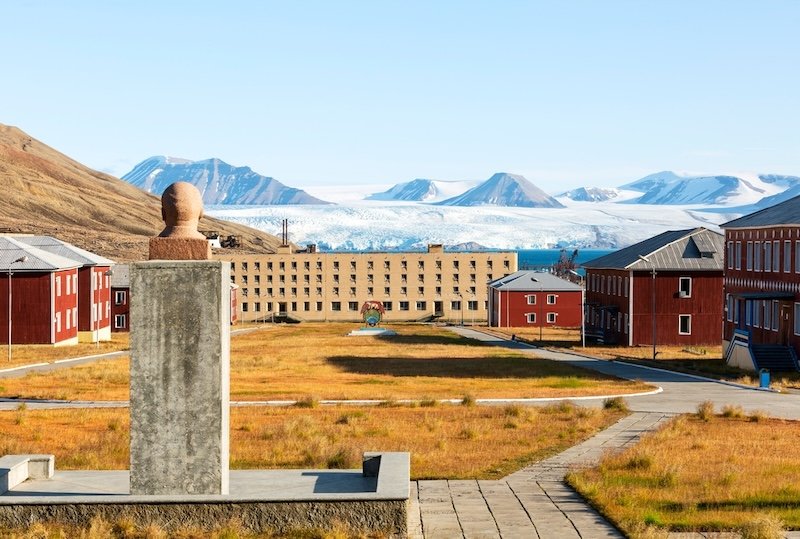
Note that you are unlikely to see a polar bear on this tour, as they don’t tend to hang out very close to Longyearbyen, but anything is possible — that’s why you always have to have a guide with polar bear protection!
If you want a chance to see polar bears, you’ll have more luck on a tour like this one, the fjord cruise to Nordenskiold, which goes near the abandoned mining town of Pyramiden, a popular polar bear hangout spot.
Note that if you’d like to go to Pyramiden, not many tours go there due to the war in Ukraine and tensions that have arisen with Russia as a result of it. However, Henningsen Transit and Guiding does offer tours there, though you won’t find it advertised by Visit Svalbard (again, due to the war).
| Overall Rating for Visiting: ⭐⭐⭐⭐ (4/5) Beautiful nearly endless days and the chance to see the midnight sun end make this a special month in Svalbard. Great conditions for all sorts of boat excursions, although August is also another peak cruise ship month, the only thing that knocks it down a star. |
September in Svalbard
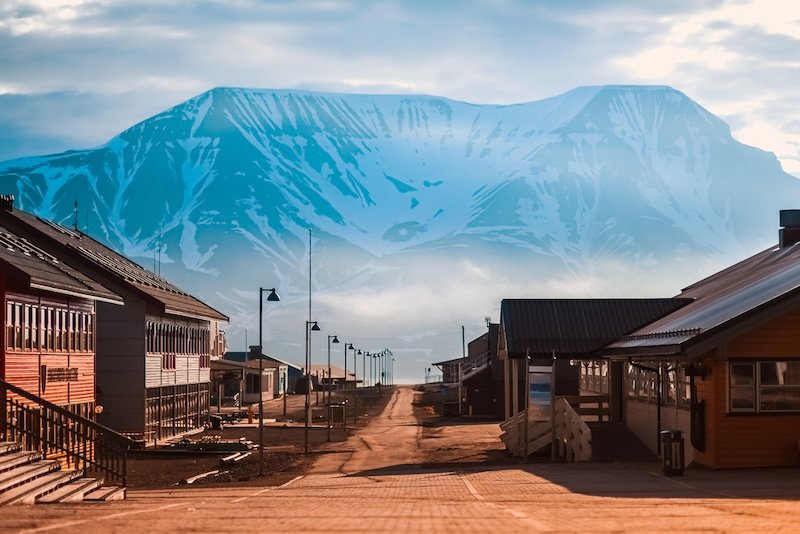
At a Glance:
- Temperatures: Average highs of 5°C (41°F), average lows of 1°C (34°F)
- Sunlight: Generally long days and short nights. The month starts with 18 hours of daylight and ends with about 11 hours.
- Activities: Sea kayaking season ends, but aurora season begins near the end of the month.
As September begins, the seas begin to get a bit rougher and sea kayaking season comes to an end, as do several boat tours, such as the one to Ny-Ålesund and the walrus watching tours.
Some continue like this nature and wildlife boat tour and the fjord cruise to Nordenskiold, though the birds tend to migrate away by mid-September, making it less appealing for birdwatchers after mid-month.
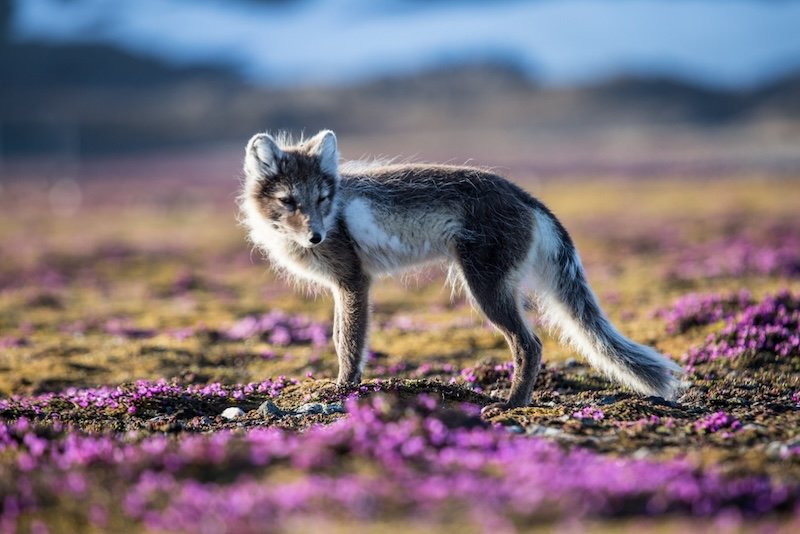
This month is quite spectacular because now that the midnight sun is over, you get some really spectacular sunsets and sunrises, and at this latitude they’re particularly long-lasting and beautiful.
You can still do some hikes and many of the land animals of Svalbard are still able to be easily spotted on a wildlife photography safari.
| Overall Rating for Visiting: ⭐⭐⭐⭐⭐ (5/5) Cruise ship season comes to a close yet still you can do a few boat tours and see some of the last remaining wildlife of the season, especially if you visit in the beginning of September rather than the end. Long days near the beginning of the month, with the chance of auroras increasing near the end of the month! |
Northern Lights Winter (October to February)
Pick Northern lights winter if…
✔️ You want to see the Northern lights (obviously!)
✔️ You’re curious about experiencing a day in the polar night
✔️ You’re on a budget and want to cut costs significantly
Skip Northern lights winter if…
❌ You get negatively impacted by low light conditions, such as if you have SAD
❌ You want to see the diversity of Svalbard’s wildlife
❌ You’ll feel like you’re missing out on a lot of its activities
October in Svalbard
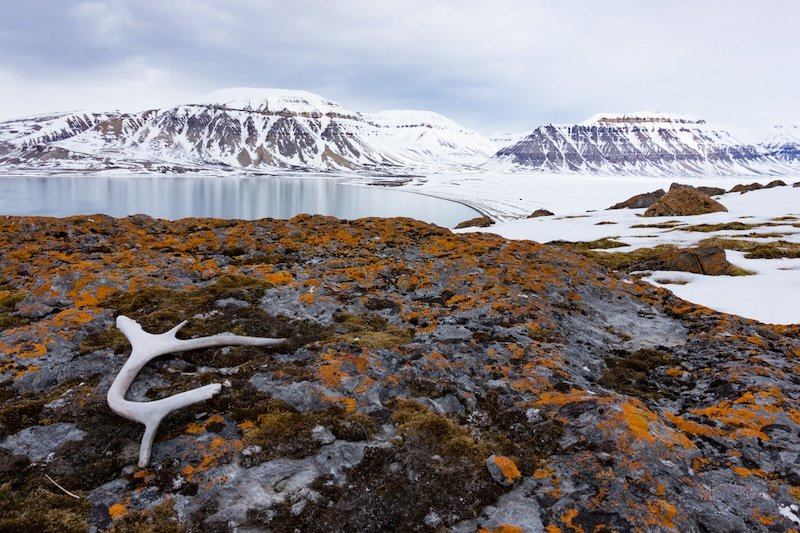
At a Glance:
- Temperatures: Average highs of 0°C (32°F), average lows of -4°C (25°F)
- Sunlight: Short but still distinguishable days at the beginning of the month with the final sunset of the year on the 25th. Twilight hours only at the end of October.
- Activities: Northern lights tours begin again, some boat tours continue
A select handful of boat tours continue through most of October, including the fjord safari to Nordenskiold, though the birds will have usually left by mid-September so this tour is more about enjoying the landscape by now, rather than the wildlife.
The month starts out with about 10 hours of sunlight, with sunrises at 7:30 AM and sunsets at nearly 6 PM. But you start losing daylight quickly, about 15-20 minutes per day for the entire month of October, speeding up rapidly in the last days before the final sunset of the year in late October.
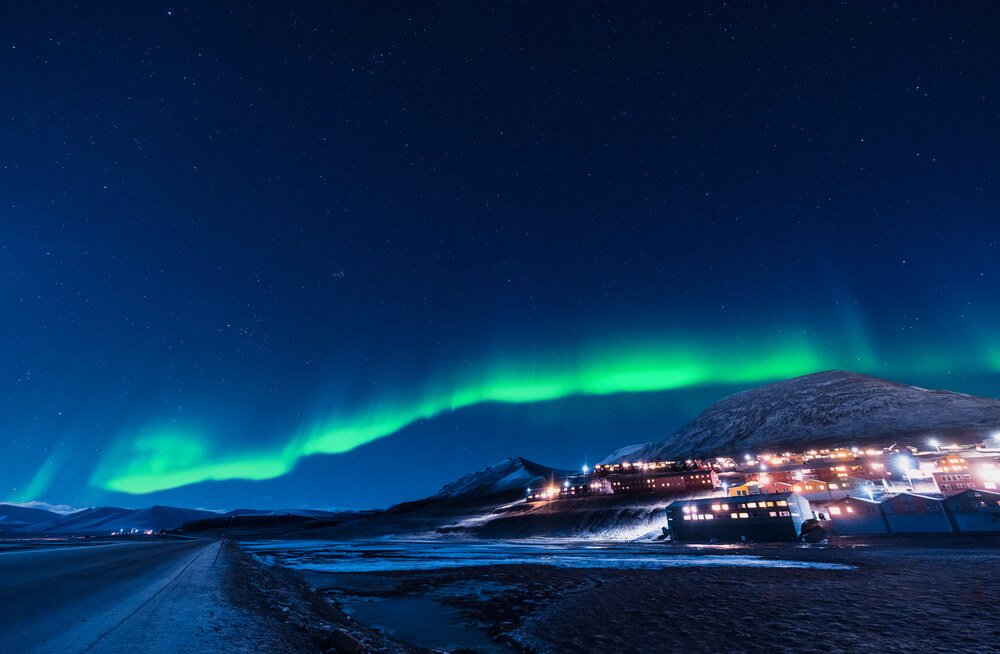
On the 25th, there are a mere two hours of daylight, and by October 26th, the sun is down all day and will be for the remainder of the year, as polar night approaches.
But that just means more time for aurora tours, and they are abundant in October — I suggest this land-based one, as none of the snowmobile tours will be running.
| Overall Rating for Visiting: ⭐⭐⭐⭐ (4/5) This shoulder season is a great time of year for those looking for good value! You compromise a bit and can do some of the last of the summer activities, like fjord safaris, while also getting to have a good chance of seeing the Northern lights. Cruise ships are gone and prices are lower, it’s not too cold yet, and the island of Spitsbergen turns a beautiful orange autumn color as it transitions into winter. |
November in Svalbard
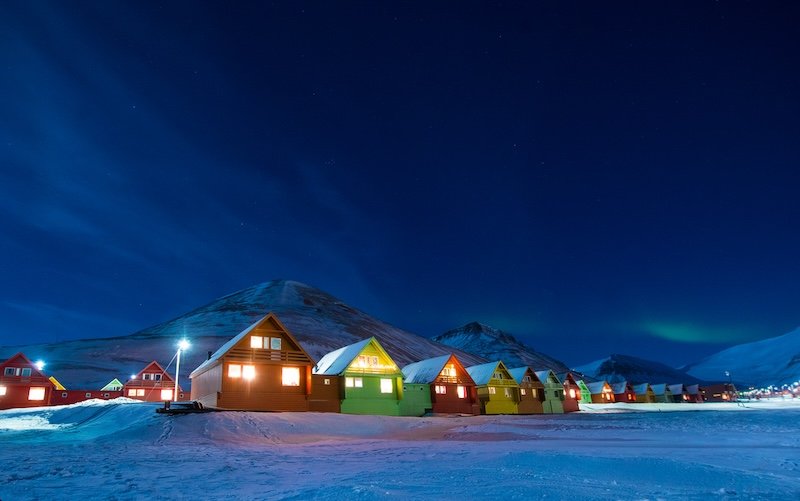
- Temperatures: Average highs of -3°C (27°F), average lows of -8°C (18°F)
- Daylight: None at all, but the first 10 days have some twilight before the true beginning of Polar Night.
- Activities: Cozy city activities around Longyearbyen like museums and cafés, Northern lights tours.
November is the first month of the winter in Svalbard where there is no sunrise or sunset. However, the first 10 days of the month have some hours of civil twilight, which is when the sun is still more than 6° below the horizon, giving you enough light that it doesn’t feel like pitch blackness.
If you come around the beginning of the month, things are a little better. November 1 starts off with a decent amount of light, with civil twilight starting around 8:45 AM and ending around 2:35 PM.
However, that quickly fades about 20 minutes per day, with November 11th being the final day with any twilight at all, and only from 10:50 AM to 12:25 PM.
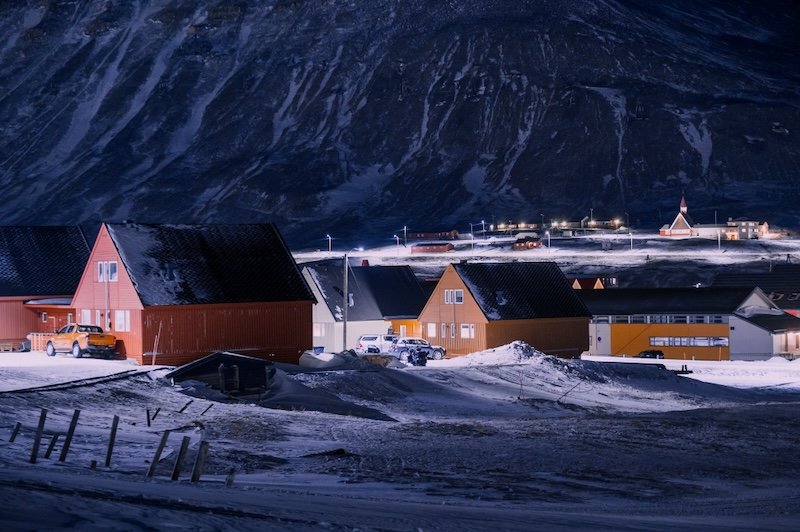
The good thing about November 11th? That’s when the Christmas hotel opens at Base Camp Explorer, adding one small cozy spark to an otherwise slightly lackluster month.
There’s not enough snow for snowmobile based activities, and it’s too dark to safely be able to do any boat tours, so you’re limited to land-based activities… by car, since there’s almost certainly not enough snow for snowmobiling yet.
There’s not much happening at this time of year, to be honest, but you could join a Northern lights chase by car if you want to increase your chances of seeing the aurora.
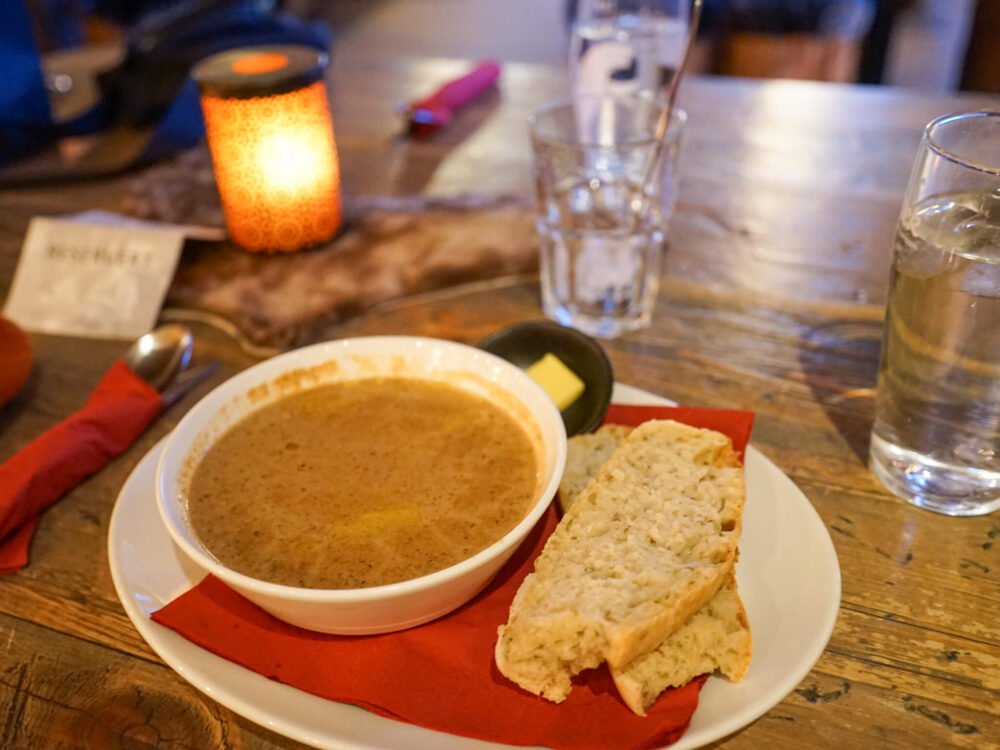
Other than that, this is a time of year to nest, eat comforting food at restaurants, shop along the main street, and just accept the darkness.
| Overall Rating for Visiting: ⭐ (1/5) With no sunlight and just a very brief period of twilight, this is a rough time of year to visit Svalbard. There aren’t yet Christmas festivities and it’s too early for snowmobile season. However, it’s not that cold yet, it won’t be crowded, and prices are very low. |
December in Svalbard
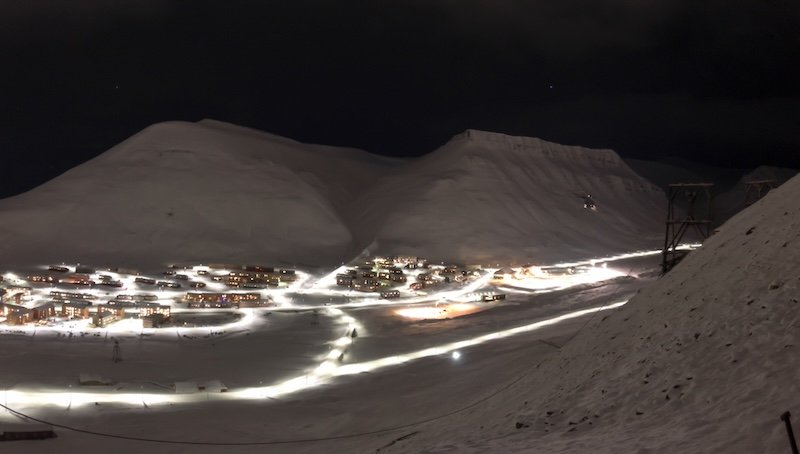
- Temperature: Average highs of -5°C (23°F), average lows of -10°C (14°F)
- Daylight: None at all, not even twilight.
- Activities: Christmas events, museums and restaurant hopping, Northern lights tours, a few snowmobile tours might begin.
There is no twilight at all in the month of December, making this a full month of the true Polar Night. The light conditions will not change virtually at all during the month of December — except during the full moons, which in the pitch black of Svalbard’s polar night, almost feel like a proper day.
Svalbard does get into the Christmas season, though, which helps add a little light back into this incredibly dark month. On the first Sunday of the Advent, there’s a torchlit march up to Santa’s mailbox (he takes up residence in a mine above Longyearbyen during December) and then back to watch the Christmas tree be lit.
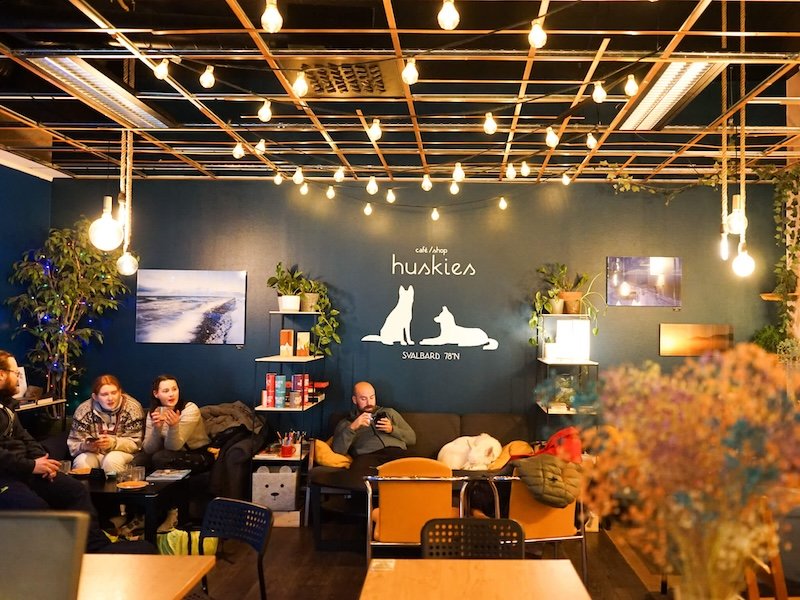
Other than that, this is mostly a month about trying to embrace the dark rather than resist it.
Think bowls of soup in cozy restaurants, enjoying drinks at the pub by a fireplace, and giving scritches to retired sled dogs at the local husky cafe.
Depending on snow conditions, some snowmobiling tours will start up again, like this one that brings you in search of the Northern lights out in Adventdalen. You can also join other Northern lights tours, like this Northern lights tour where you chase the lights by car.
| Overall Rating for Visiting: ⭐⭐ (2/5) The Christmas décor and festivities make polar night more festive, and there’s a chance of having enough snow to do things like dog sled and snowmobile as long as there has been enough snow. Still, the darkness is quite oppressive and doesn’t let up at all, so it’s hard to see the beauty of the landscape. |
January in Svalbard
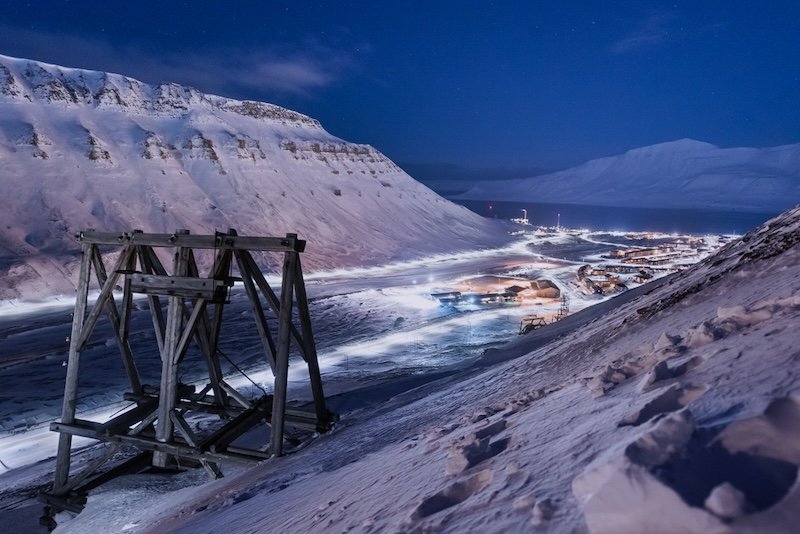
- Temperature: Average highs of -5°C (23°F), average lows of -10°C (14°F)
- Daylight: None, although polar night officially ends on the 29th, and a few hours of twilight begin to appear each day as the “Blue Hour” season approaches.
- Activities: Museums and restaurants in Longyearbyen, Northern lights tours, some snowmobile tours.
Polar night continues until the end of January, officially ending on January 29.
That’s when civil twilight returns, even if just for less than an hour (from around 11:50 AM to 12:30 PM, in fact). By January 31, that extends to a few hours of twilight, from 10:55 AM to about 1:25 PM.
All those hours of darkness leave you plenty of time to chase the Northern lights by car or by snowmobile (there are shorter tours and longer tours that include time at an aurora camp located inland which is the best place to have a shot at seeing the lights, away from the coast).
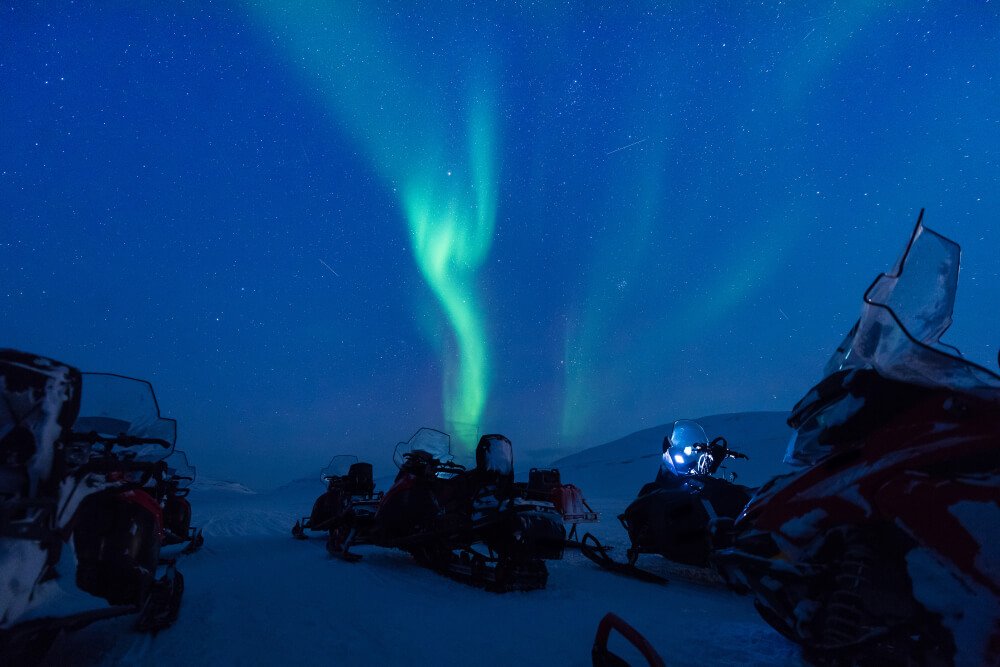
Even though there’s enough snow, not all the snowmobile tours are back up and running: just the Northern lights-focused ones. That’s because you can’t really see much, so the landscape-focused tours won’t start up again until February or even March.
In lieu of snowmobiling, there are a few dog sled tours you can do, such as this dog sled tour to an ice cave (starting mid-January), or this dog sled tour in search of the Northern lights.
| Overall Rating for Visiting: ⭐⭐ (2/5) Still a very dark month, though there’s some light at the end of the tunnel near the end of the month. Snowmobiling is generally possible, but with polar night very much on for nearly the entire month, most tours do not run. Dog sledding is a good option too, but like December, you won’t get to see much of Svalbard’s landscape in the pitch black. |
February in Svalbard
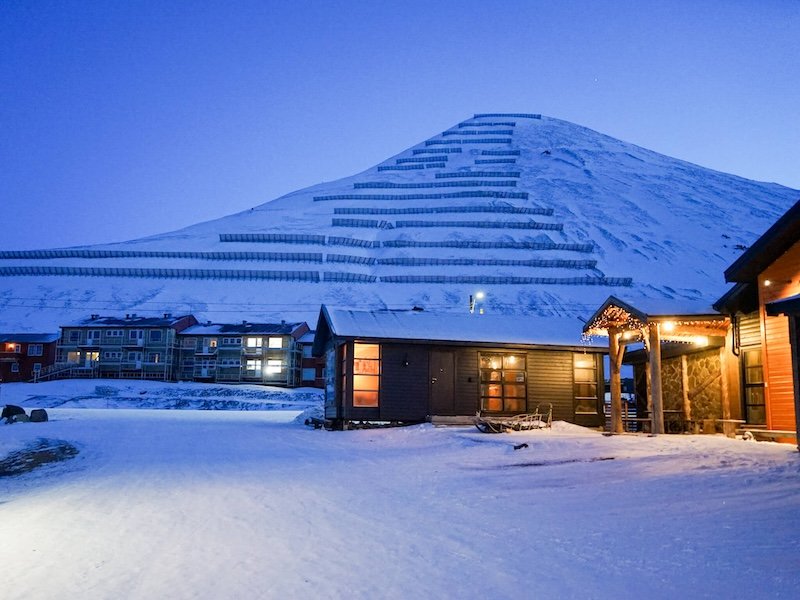
- Temperature: Average highs of -6°C (21°F), average lows of -11°C (12°F)
- Daylight: None at the beginning of the month, but some twilight and “blue hour” The sun rises above the horizon after the 15th, but won’t yet fall onto Longyearbyen until March.
- Activities: dog sledding, ice caves, Northern lights tours, snowmobiles
This month changes quite rapidly in Svalbard, and it’s when the real winter tourism season begins in earnest… yes, after four months of ‘winter’ have already passed. That’s what happens when there’s about 2/3 of the year in some state of winter!
The first half of the month has no true sunrise or sunset. On February 1, civil twilight lasts from 10:40 AM to around 1:40 PM… a whopping 3 hours of mild blue light. But by around February 14, the last day without any sunrises, that civil twilight period lasts between 8:30 AM and 3:55 PM, giving you what feels like almost a full daytime.
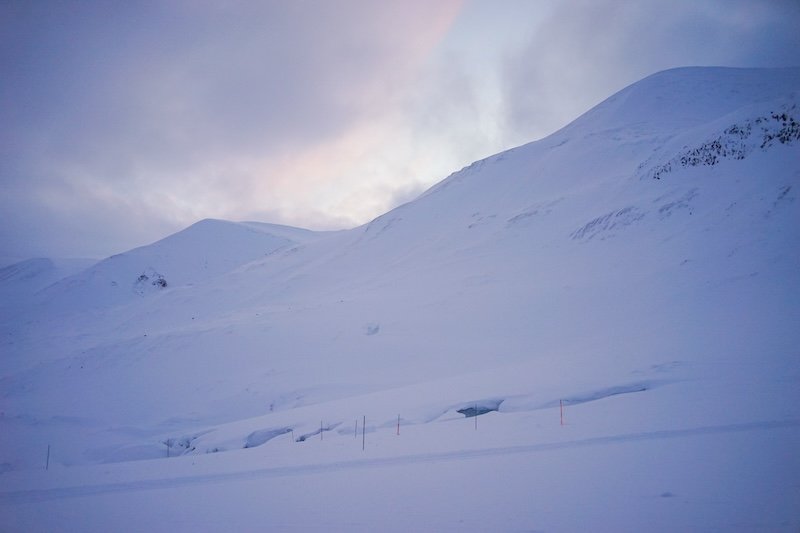
The sun starts to rise around February 15, but you won’t see the sun in Longyearbyen village until March. Still, as soon as the sun starts rising, days get a lot longer and brighter even if you can’t lay eyes on the sun.
On the 15th, the sun rises from 11:30 AM to 12:50 PM, but then by February 28th, the sun is up from between 8:30 AM and 3:45 PM, and twilight extends that brightness by about two hours before and two hours after sunrise and sunset.
As the sunlight returns, so do the snowmobile tours that explore more of the island for more than just the Northern lights.
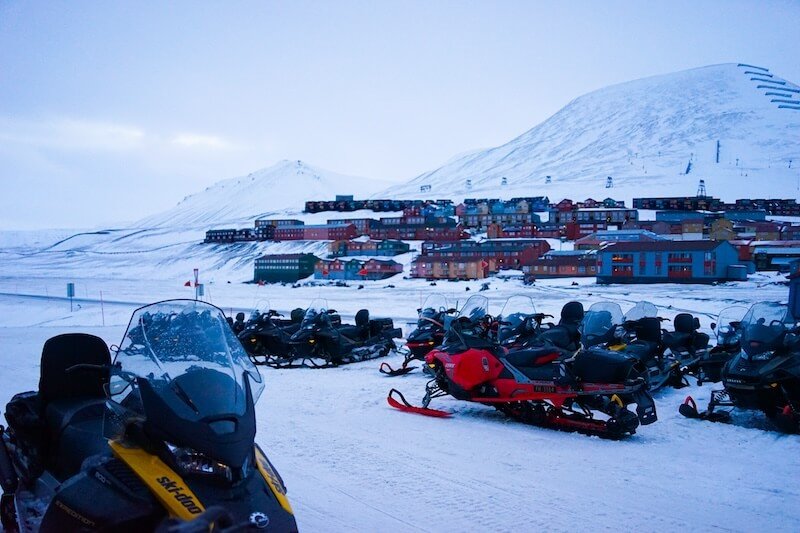
Halfway through the month, the snowmobile tour to Eastern Spitsbergen begins, which is one of the coolest snowmobile tours you can do on the island. You can also snowmobile to the ice caves in a glacier, or visit the same ice caves a more adventurous way… by dog sled!
This is the last full month of aurora watching, so you can join an aurora tour by car or by snowmobile (there are 3.5 hour shorter tours and longer tours (about 7 hours) to an inland aurora camp.
| Overall Rating for Visiting: ⭐⭐⭐⭐ (4/5): Another slice of shoulder season perfection, especially if you visit near the end of the month. The twilight conditions are quite beautiful, giving Svalbard its famous “Blue Hour” color. But if you visit near the beginning or the end of the month, the sunlight conditions can still be quite challenging for many visitors. It’s quite cold, which is fine, but there are often a lot of winter storms this month, making it less likely to see the Northern lights. |
Allison Green is a former teacher who has been travel blogging since 2016. She has a Masters in Teaching and a B.A. in English and Creative Writing. Her blog posts merge her background as an educator with her experience traveling to 70+ countries to encourage ethical, meaningful travel. She has been a speaker at the World Travel Writers Conference and her writing, photography, and podcasting work has appeared in National Geographic, CNN Arabic, CBC Canada, and Forbes, amongst others. Now a full-time traveler, she has lived in Prague, Sofia, New York City, and the San Francisco Bay Area.